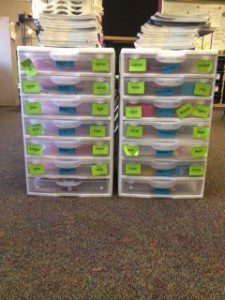Back when I was a freckle-faced, curly-topped, four-eyed third grader, my teacher said to me, “Erica, you are not smart enough to be in that group!” Today, having been a teacher myself, I’m certain those are not the exact words my third grade teacher told me all those years ago, but that is definitely what I heard, and dumb is definitely how I felt!
If your school experience was like mine, you were probably a Red Bird or a Blue Bird, or whatever name your teacher gave to your “group.” In my experience, my group name referred to the textbook we read all year long. The group never changed. The materials never changed. If you were a Red Bird in September, you were a Red Bird in March. For me, as for many kids, this type of instruction was not a positive experience.

Fortunately, thanks to educational research and quality professional development, teachers teach differently today than they did when we were in school. Unfortunately, that leaves us parents with a lot of questions.
In honor of National Education Week, I thought I could shed some light on a popular instructional strategy that is occurring in many of your children’s classrooms. This strategy is differentiation.
In teacher terms, differentiation means adjusting instruction to meet the individual and specific needs of a student learner.
In mommy terms, differentiation is a lot like cooking dinner for your family. Carey needs gluten free, Jared doesn’t drink milk, your husband doesn’t like onions, and the baby needs soft, bite-size portions. And you feel like tacos! So you give Carey a gluten free tortilla, Jared has a glass of water instead of milk, you leave the onions off for your husband, and you cut up grapes, pieces of tortilla and beans for the baby. Viola! You just differentiated your dinner!
Notice how everyone accomplished the desired outcome: they ate their dinner. You as the cook had to make substitutions, change items, leave items out, and break up items into smaller portions to meet the needs of your family. This process probably took some extra thought and preparation, but everyone ended up fed – just as you intended!
This is, essentially, what teachers are doing in the classroom.
Differentiation can be done in:
Content: The skill or standard being taught. Content can be extended if a student has already mastered an objective, or modified if a student is struggling.
Process: How the student learns. Use of time, task, and manipulatives are considered here.
Product: The final assignment will not be the exact same for each student. May be evaluated by a rubric, or checklist.
Learning Environment: The organization and flow of a classroom. Whole group, small group, and individual learning spaces are clearly recognizable.
Differentiation can be choice.
There is power in choice. Here the teacher chooses all acceptable choices and the student chooses within them. For example, my Kindergarten son comes home with a tic-tac-toe paper listing all his learning centers. He completes all the centers but chooses the order in which he wants to do them.
Differentiation is constantly changing!
Groups should not be stagnant. They should change based on skill, standard, or project.
Differentiation is based on assessment:
Yes, assessment is a HUGE buzz word in education, and it should be the driving force in how teachers differentiate! But it’s not just bubble sheets that tell teachers how to differentiate. They use rubrics, checklists, unit assessments, and less formal assessments like exit slips, one-on-one conferencing, and observations in daily work.
When parents begin to understand what differentiation is, they then question how teachers manage and organize it.
The management and organization of differentiation can look different from classroom to classroom. However, there will be many similar factors that help the teacher and students know expectations and directions. Here are a few things you’ll see in a differentiated classroom:



It has also been my experience that differentiation gets a bad rap, but this is usually because it’s being conveyed wrong. For that reason, here is a list of what differentiation is NOT:
A different worksheet:
A worksheet is a worksheet. If it is the same skill, same level, and no new instruction is offered, it is in fact busy work, not differentiation.
Doing more of the same:
More is not always better. It can become redundant, boring and masquerade as busy work. Similarly, doing more of something you don’t understand can be discouraging and deflating.
Small groups:
If every small group is reading the same book, or working on the same journal pages, or consists of the same kids all year long, this is not differentiation; it is just small groups.
Whole class:
If your child’s class sits in desks… in rows… and the teacher sits up front talking… all day long…this is not differentiation. This is a lecture, and developmentally inappropriate , especially for elementary aged kids.
In place of an IEP or a 504:
If your child has an Individualized Education Plan, or a 504 plan, differentiation does not substitute for either. Differentiation should work alongside your child’s plan, even enhance it, but it is not an either/or.
Just for the low kids:
Differentiation works for all kids – high, low, and all the levels in between.
Just for reading:
Differentiation is for all subjects.
So now that you know, what can you do?
- Ask your teacher, “How are you using differentiation in your classroom?”
- Attend PTO meetings as they usually address curriculum in your children’s school.
- Ask the principal what professional development teachers receive in differentiation and what his expectation is for teachers.
- Offer tips on your child’s learning style: “Likes working in groups, likes hands-on projects.”
- Remember, you are your child’s top advocate. If you question, worry, or are confused, ask!
- Teaching a truly differentiated classroom takes time to learn and manage. If you notice your teacher trying new things, support and encourage her.
I hope this has helped you gain a little insight on how differentiation is implemented in your child’s classroom. Again, the best way to learn more is to talk with your child’s teacher. She is your partner in your child’s education.
*Special thanks to my friends at Brookview Elementary for supplying the pictures!















